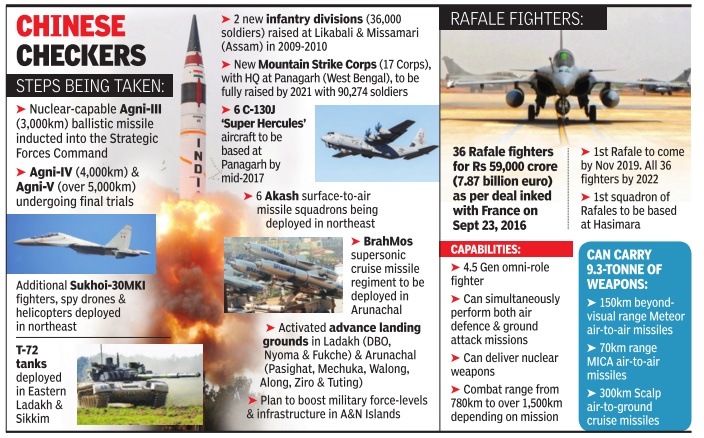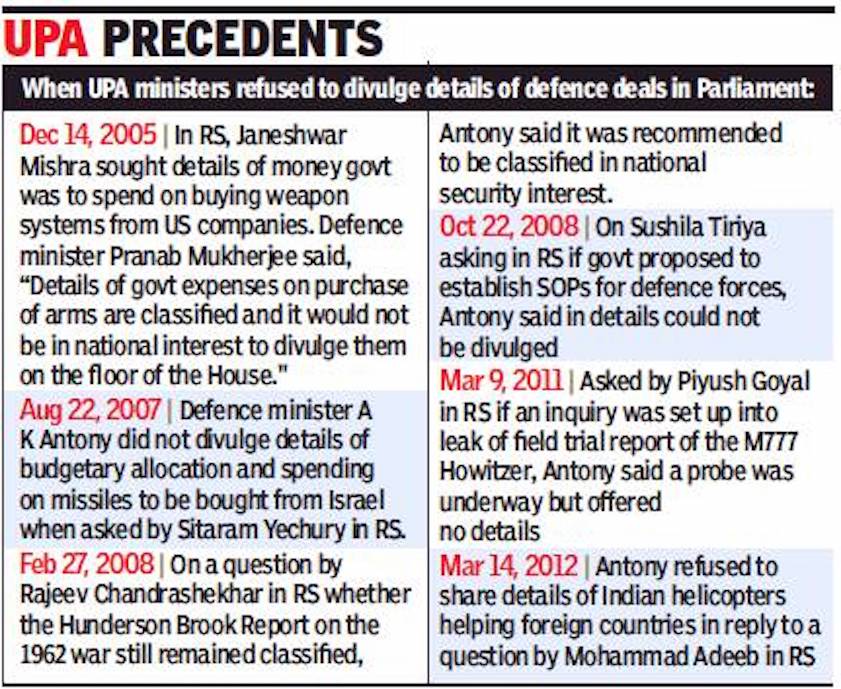Rafale fighter jet and India
This is a collection of articles archived for the excellence of their content. |
Contents |
Rafale twin-engine multi-role fighter jet
The first squadron
Rajat Pandit, Dragon's lair on Rafale flight path, Jan 7, 2017: The Times of India

First Squadron Will Be Based In Bengal To Boost Firepower In Eastern Sector
India will base its first squadron of Rafale fighter jets, which are also capable of delivering nuclear weapons, in the eastern sector as part of the overall policy to gradually build nuclear as well as conventional deterrence against China.
With Sukhoi-30MKI fighters already operating from Tezpur and Chabua in Assam, the IAF has now finalised plans for the first 18 Rafales to be stationed at the Hasimara airbase in Bengal from late-2019.This comes at a time when India is also conducting final trials of the nuclear-capable Agni-IV and Agni-V ballistic missiles after the Strategic Forces Command inducted the AgniIII a couple of years ago.
Under the Rs 59,000 crore (7.87 billion euro) deal inked with France in September last year, the IAF will get 36 Rafales in batches by mid-2022 or so. With 14 India-specific requirements, including the capability for “cold start“ from high-altitude regions, the Rafale packs quite a punch with its ability to carry 9.3-tonne of weapons and simultaneously perform both air defence and ground attack missions.
“The Hasimara airbase currently has MiG-27s that will be retired over the next two-three years. They will be replaced by Rafales. A team from Dassault Aviation has already visited Hasimara to review the maintenance and other infrastructure required there,“ said an official.
“The Sarsawa base (UP), among other places, is being considered for the second Ra fale squadron. Under the contract, Dassault has to ensure minimum 75% availability for the jets at all times under the performance-based logistics support for the first seven years, which can be extended by another five,“ he added.
The IAF also activated the advance landing ground (ALG) at Tuting, in Arunachal's Upper Siang district, just 10 days ago. It is the sixth such ALG to be made operational in Arunachal apart from the ones in eastern Ladakh, all with an eye firmly on China.
Moreover, the Panagarh base in Bengal is also set to get its six C-130J Super Her cules aircraft. Panagarh, of course, is also going to be the headquarter of the Army's new 17 Mountain Strike Corps being raised with two high-altitude infantry divisions, apart from other armoured, artillery , air defence and engineer brigades spread from Ladakh to Arunachal.
UPA precedents (vis-à-vis Rafale)
NDA’s Rafale deal 9% cheaper than UPA’s, asserts Prasad, July 24, 2018: The Times of India

From: NDA’s Rafale deal 9% cheaper than UPA’s, asserts Prasad, July 24, 2018: The Times of India
BJP said the Rafale price negotiated by the Modi government for each French fighter jet was 9% less than what was negotiated by UPA.
With Congress persisting with its charge of bribery and the claim that the government wrongly invoked the “secrecy” clause to keep a lid on details of the deal, BJP fielded law minister Ravi Shankar Prasad to issue a rebuttal. “UPA invited quotes for 126 aircraft in 2007. The price quoted for each was 79.3 million euros which also had in-built escalation formula. When the bid was opened in 2011, the proposed cost in the bid document was 100.85 million euros per aircraft. However, this could not be finalised. After NDA came to power, under the inter-government agreement in 2016, the cost per aircraft finalised was 91.75 million euros. Therefore, the price determined during NDA government is 9% lower than what was negotiated during UPA. The corresponding cost in Rs 670.32 crore per aircraft has been conveyed to Parliament,” he said.
Prasad said the allegation of corruption was “manufactured” to establish an equivalence between the UPA and the Modi government on the issue of corruption, and insisted that specific details of the deal could not be disclosed not just because doing so would violate the secrecy clause signed with the French, first under the UPA, but also because it would be detrimental to national security.
“The cost gives an indication of the additional weaponry and capacity to the aircraft. This was UPA’s own stand on several occasions. To ask for disclosure of the same implicitly means that the enemy has to be informed of the capacity and weaponry of our combat aircraft.”
The allegations and the defence
The allegations and the defence
Decoding Rafale deal: From allegations to counter-allegations, August 29, 2018: The Times of India
As the controversy surrounding Rafale deal escalates, here is an explainer and a timeline relating to India's purchase of 36 combat jets from France for an estimated Rs 58,000 crore:
What is Rafale?
Rafale is a French twin-engine multi-role fighter jet designed and built by Dassault Aviation. The Rafale jets are considered one of the most potent combat jets globally.
What was the UPA deal?
India began the process to buy a fleet of 126 Medium Multi-Role Combat Aircraft (MMRCA) in 2007 after the defence ministry, headed then by Congress leader A K Antony, cleared the proposal from the Indian Air Force.
The contenders for the mega deal were Lockheed Martin's F-16s, Eurofighter Typhoon, Russia's MiG-35, Sweden's Gripen, Boeing's F/A-18s and Dassault Aviation's Rafale.
After a long-drawn process, bids were opened in December 2012 and Dassault Aviation emerged as L-1 (lowest bidder). In the original proposal, 18 planes were to be manufactured in France and 108 in India in collaboration with the Hindustan Aeronautics Ltd.
There were lengthy negotiations between the then UPA government and Dassault on prices and transfer of technology. The final negotiations continued till early 2014 but the deal could not go through.
Details of the negotiated price per Rafale were not officially announced, but it was suggested by the then UPA government that the size of the deal would be $10.2 billion. The Congress claimed per aircraft rate including avionics and weapons was zeroed in at Rs 526 crore (As per Euro exchange rates prevailing then).
What was the deal finalised by Modi government?
During his visit to France, Prime Minister Narendra Modi on April 10, 2015, announced India will purchase 36 Rafale jets in a government-to-government agreement. After the announcement, questions were raised by the Opposition on how the PM finalised the deal without approval of the Cabinet Committee on Security.
A joint statement issued on April 10, 2015, after talks between Modi and then French President François Hollande, said they agreed to conclude an Inter-Governmental Agreement for supply of 36 Rafale jets on terms that would be better than conveyed by Dassault Aviation as part of a separate process underway.
The statement said the "aircraft and associated systems and weapons would be delivered on the same configuration as had been tested and approved by Indian Air Force, in clear reference to negotiations and testing process for the Rafale jets under the UPA government.
The Final deal?
India and France signed an Euro 7.87-billion (Rs 59,000 crore approximately) deal on September 23, 2016 for 36 Rafale jets. The delivery of the aircraft will start from September 2019.
The deal was finalised on the basis of the procurement procedure followed under the UPA government.
The allegations?
The Congress has been accusing massive irregularities in the deal, alleging that the government was procuring each aircraft at a cost of over Rs 1,670 crore as against Rs 526 crore finalised by the UPA government. The party has also demanded answers from the government on why state-run aerospace major HAL was not involved in the deal.
The Congress has also sought to know price details of the aircraft and how the rate per aircraft has gone up from Rs 526 crore to Rs 1,670 crore. The government has refused to share the details, citing a secrecy clause of a 2008 pact between India and France.
Congress' A K Antony, who was defence minister in 2008 when India and France inked an inter-governmental agreement on defence procurement, said the government's claim that the secrecy clause was forcing it to not reveal price details of the deal was "totally wrong".
The party claimed that Qatar had purchased 12 Rafale fighter jets in November 2017 for $108.33 million per aircraft (Rs 694.80 crore).
The Congress has also alleged the government was benefitting the Reliance Defence Ltd (RDL) through the deal as the company has set up a joint venture with Dassault Aviation to execute the offset obligation for the Rs 59,000 crore deal.
The has party alleged Reliance Defence was formed just 12 days before the announcement of the Rafale deal by the prime minister on April 10, 2015. The RDL has rejected all the charges.
Under India's offset policy, foreign defence entities are mandated to spend at least 30 per cent of the total contract value in India through procurement of components or setting up of research and development facilities.
On October 3, 2016, RDL and Dassault Aviation announced a joint venture (JV) in the aerospace sector and a year later, foundation stone of a manufacturing facility was laid in Mihan, Nagpur.
The government's response?
Around two years back, Minister of State for Defence, while replying to a question in Parliament, had said the cost of each Rafale aircraft is approximately Rs 670 crore but did not give details of prices of associated equipment, weapons and services.
Later, the government refused to talk about the prices. It has been maintaining that the cost of 36 Rafale jets cannot be "directly compared" with the original proposal to buy 126 combat aircraft as "deliverables" were significantly different.
Finance Minister Arun Jaitley wrote a Facebook post today, accusing Congress and its leader Rahul Gandhi of "peddling untruth" and carrying out a "false campaign" on the deal. He said the deal signed by the NDA government was on better terms than the one agreed to in 2007 under the UPA regime.